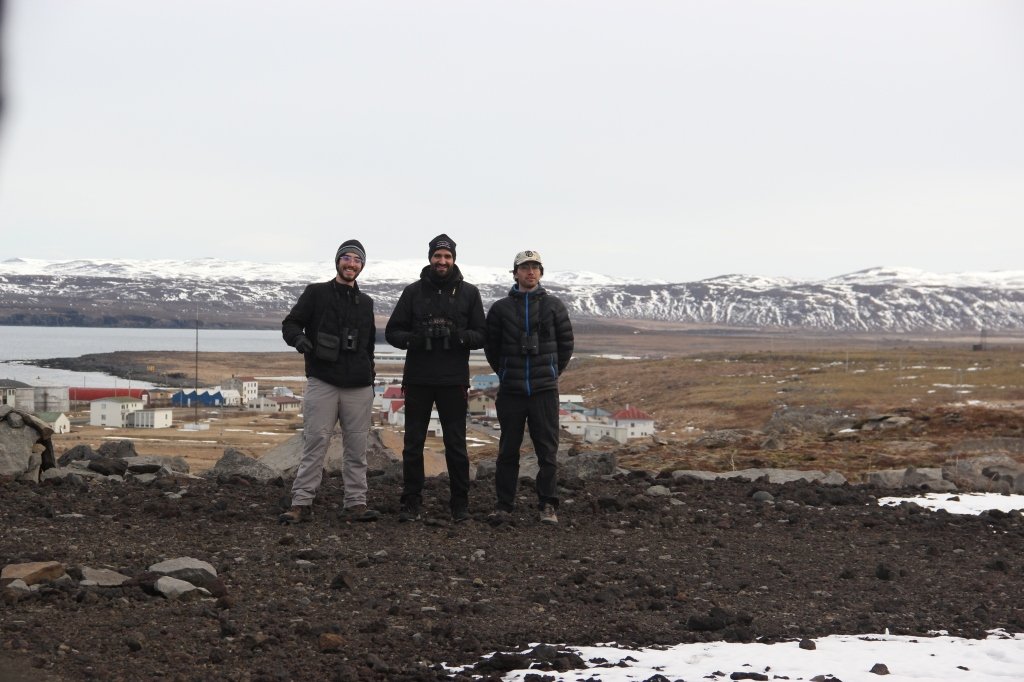text by Oscar García Miranda and José O. Valdebenito
Traversing the thick blue mist that shrouds the cliffs of the Melrakkaslétta peninsula, with the midnight sun illuminating the lonely lighthouses of the coast (Image 1), we arrived the first days of spring to Raufarhöfn, one of the northernmost town in Iceland (66°27’07.8″N, 15°56’56.8″W). About 70 years ago, this town thrived with life, with a population of around 3000 people. Unfortunately, since the collapse of the herring industry in the 1960s, the town saw a progressive reduction of about 10 times. To this day, only a few still subsist from fishing. Despite the rather gloomy history of the town, this area as well as most of the eastern side of the peninsula has unique geographical features that enable high concentration of feathery hosts each year.


We were fortunate to stay at the Rif Field Station (Image 3), an organization established in 2014 surrounded by an idyllic array of habitats for breeding birds. In fact, at all times, within and around the village, it was possible to see plenty of birds, most of them shorebirds. Table 1 encloses a list of all shorebirds observed in the area.


As it is usual in the Arctic, one is just a pawn as nature rules. During the first two weeks the weather conditions were pretty challenging, which stopped us from going out in the field as well as delayed breeding. After that small crisis the season progressed as expected, and we managed to find a total of 22 nests across different habitats (Image 4). It is crucial to mention that several nests this year were found just a few meters (~10 meters) from the sites where they nested in 2021, thus revealing a probable high site fidelity (example in Image 5).
According to comments from locals, Red-Necked Phalaropes did not breed in the area. Therefore, this year, as we did the year before, we did not look for Red-Necked Phalarope nests. We instead concentrated on conducting regular sex-specific censuses where we observed that females arrive first and as the season progresses, males arrived in increasing numbers (Image 6). Because this is a sex-role-reversed species, where females arrive first to stablish their breeding territories, our observations suggest that they are probably nesting there, we just didn’t spot them!



Upon capture, we collected blood samples of each bird for the stage two of an INTERACT project entitled Association of mating system variation with sex-specific immune function and gut microbiota in shorebirds. This project uses shorebirds to predict associations between immune investment and sex, based on their sexual dimorphism and sex roles. In addition, this year we also conducted core ÉLVONAL Project data colletion and collected feces as part of the collaboration with Dr. Evangelos Mourkas from the University of Bath, who is researching Campylobacter in wild birds (Image 8). We managed to capture individuals of the following species:
Common Ringed Plover (Charadrius hiaticula)
Common Snipe (Gallinago gallinago)
Dunlin (Calidris alpina)
European Golden Plover (Pluvialis apricaria)
Purple sandpiper (Calidris maritima)
Red-necked Phalarope (Phalaropus lobatus)
Sanderling (Calidris alba)




When the Rock Ptarmigans were beginning to lose their winter plumage (Image 9), after the celebration of the fisherman’s day, we said goodbye to Raufarhöfn. But, just like its birds, we hope to return next year to continue ringing, trapping phalaropes, and recording nests.
If you ‘d like more information about this site, do not hesitate to contact us!
<oscar.garcia.miranda[at]outlook.com>

This expedition would not have been possible without the invaluable help of Dr. Pedro Rodrigues, director of the Rif Field Station. Nor would it have been successful without the management of the accommodation of Halldóra Gunnarsdóttir at the Nest Guesthouse. Furthermore, we are indebted to Prof. Tamás Székely and Prof. Sam Sheperd for their collaboration and support before, during and after the expedition.
